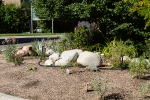Do you have a problem area where nothing will grow; or there is a particular problem? There is an area like that at our demo garden. In front of the Extension building along the sidewalk the grass has been replaced a couple of times. In the winter the snow melt and piled up snow kill the grass along the sidewalk.
Our project this workday was to take care of that area. Thanks to Patrick and Paul from the county who came and stripped out the dead grass. It was a small group of Al, and Sherrie and Gloria who laid down some rock mulch. The plan is to put annuals in that space since nothing can overwinter there.
Two years ago there was a real problem area where nothing would grow. For seven years it was just covered with weed barrier and rock because there was no success putting anything there. We’ve learned a lot in the last few years about low water plants and trying native plants in those problem areas. We stripped out the weed barrier and moved all the rock and decided to try the right plants for the right place. We made a xeric garden out of it and put some low water plants there and we’re excited with the results. This will be the third year for that area after redoing it and we’re happy to say that plants are growing and doing well there.
- second year
- Xeric garden – used to be ugly
- Xeric garden
So, with a little research and thought to come up with a plan you can turn those pesky areas into something attractive.
Some of the Master Gardeners went on a tour of Pat Hayward’s garden. Pat was the director of Plant Select and her gardens are wonderful. All of her plants are extremely low water. After watering to establish the plants they don’t water them at all. The native plants are planted with no amendments and they used rock for their mulch. It was a great day and a real treat to see Pat’s gardens. Her new book was available to purchase. It’s a book about tough native plants for tough places.
Permission from Pat to use photos from the tour in our blog:
http://extension.colostate.edu/topic-areas/yard-garden/native-herbaceous-perennials-for-colorado-landscapes-7-242/
http://extension.colostate.edu/topic-areas/yard-garden/native-shrubs-for-colorado-landscapes-7-422/
http://extension.colostate.edu/topic-areas/yard-garden/native-trees-for-colorado-landscapes-7-421/
After we left pat’s we went to take a tour of the CSU gardens. The gardens at CSU are test gardens for new plants or new varieties. It could take up to three years, with photos taken every week to test the plants and give results to companies asking for their help. The annuals have been there a long time but the perennials are somewhat new. They started out with a small perennial garden and now it’s grown substantially. The plants are all labeled and the gardens are open so you can go up and tour any time you would like. It as fun to see all the new colors of petunias and calibrachoas before they are for sale. The gardens at the end of the tour have all been moved. They were where they built the new football stadium on campus. A very HUGE job. The new garden is not quite established yet. Next year it should look much better after it’s been there a year.







